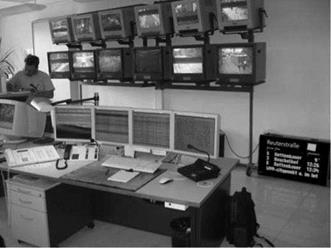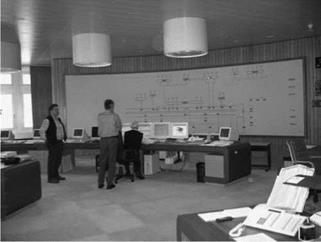Depending on the requirements and the application, there are several technologies available that can be used in control room environments. Only the more advanced technologies will be covered here. The old-fashioned technologies such as monitor walls consisting of a matrix of CRT monitors or cubes will not be explained in detail.
4.5.1 Cathode Ray Tube (CRT) Monitor Wall
Disadvantages:
• High energy consumption
• Inflexible display
• Large required space
• High maintenance costs
• Complexity of display
• Old-fashioned display
• Bad ergonomics
• High thermal load
• With CRT monitors, burn-in of static images
• Large spaces in between the single display units (Figure 4.15 and Figure 4.16)
4.5.2 Mimic panel Display
Mimic panel display (mosaic display) was mainly used in the energy area and in process control, but this technology is not very flexible. It is also very expensive and considered to be old-fashioned. Increasingly, more and more users are changing from this technology to the more modern display technologies (Figure 4.17).
There are two types of such displays: linear displays and graphic displays. Linear displays consist of an array of lamps presented with labels for each lamp function.
|
FIGURE 4.15 Example of a CRT monitor wall. |
|
FIGURE 4.16 Example of an integrated system. |
|
FIGURE 4.17 Example of a wall display. |
Lamps are normally situated in rows and columns. The label should be sufficient for the operators to identify the nature of any problems. The disadvantage of these systems is that the lack of precise location information requires the operator to have knowledge of the facility to precisely identify the problem for the responding personnel.
The other type of display is called graphic display. These consist of lamps arranged over a graphic representation of the monitored area. The lamps are normally coloured and situated to show the location and nature of the alarm. Labels can be added for more clarity. The advantage of graphic compared to linear displays is the clear presentation of the nature and location of the alarm in relation to the area being monitored. Multiple alarms can be identified more quickly because
the graphic display shows their relationship. Responding personnel can usually be directed more accurately. Typically, these systems have a larger size and higher cost than linear displays.






